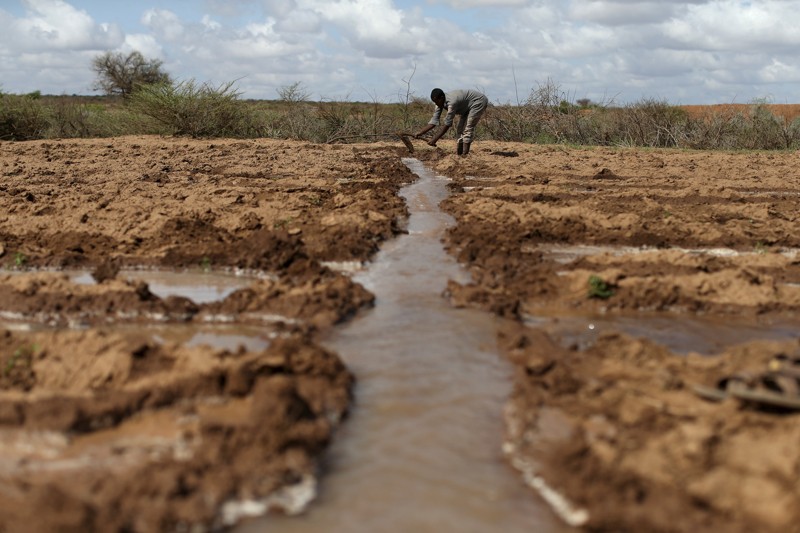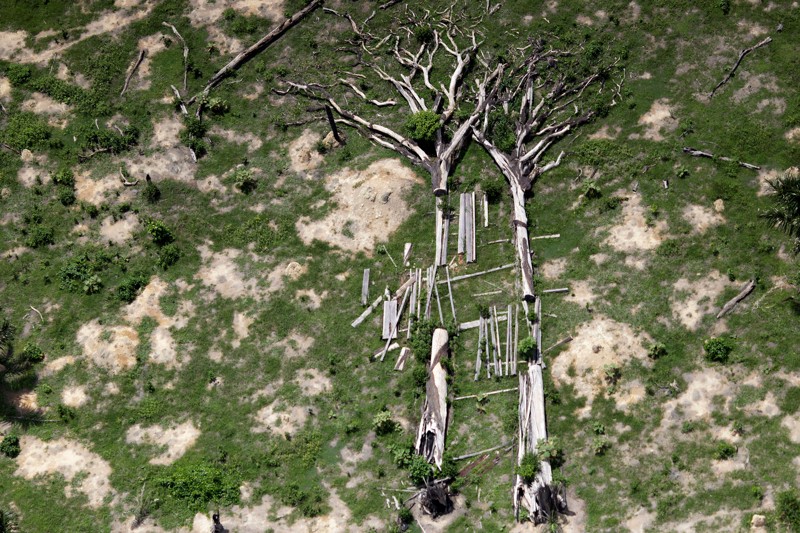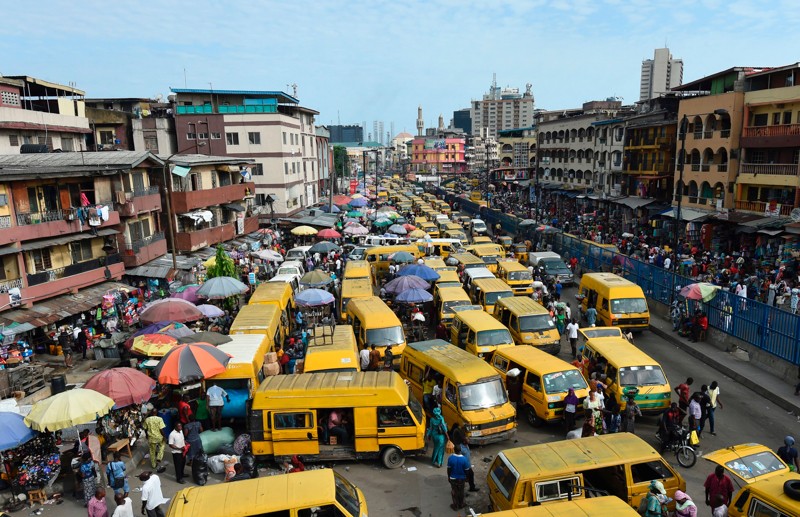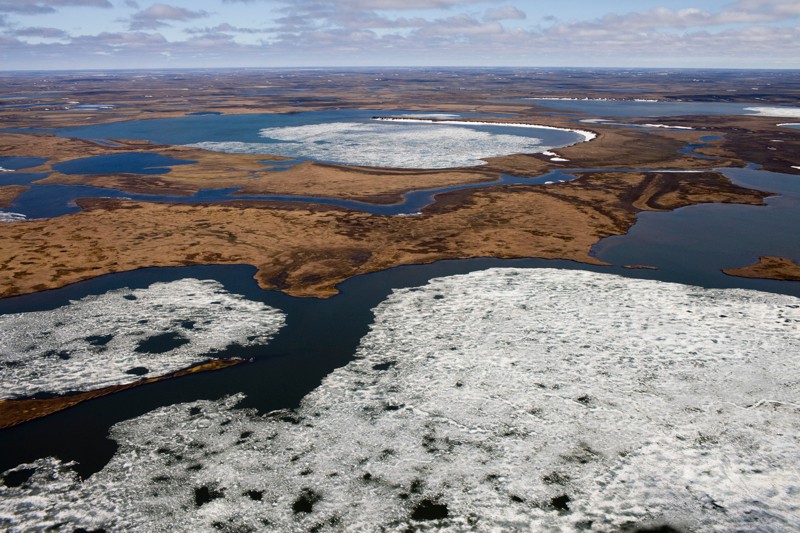An enclosure for measuring gas exchange between plants and the atmosphere at a station in Finland.Credit: Juho Aalto
Climate change. Water and food security. Urban air pollution. These environmental grand challenges are all linked, yet each is studied separately.
Interactions between Earth’s surface and the atmosphere influence climate, air quality and water cycles. Changes in one affect the others. For example, increasing carbon dioxide enhances photosynthesis. As they grow, plants withdraw greenhouse gases from the atmosphere, but they also release volatile organic compounds such as monoterpenes. These speed up the formation of aerosol particles, which reflect sunlight back into space. Our actions — such as emission-control policies, urbanization and forestry — also affect the atmosphere, land and seas1–5.
Satellites and stations on the ground track greenhouse gases, ecosystem responses, particulate matter or ozone independently of each other. Coupled observations are occasionally performed, but in intensive bouts. Vast areas of the globe — including Africa, eastern Eurasia and South America — are barely sampled.
The result is a cacophony of information that yields little insight. It is like trying to forecast weather in November with spotty measurements of rain, wind, temperature or pressure from June.
African nations such as Somalia need better monitoring of water cycles to improve strategies that help to retain soil moisture.Credit: Siegfried Modola/Reuters
The answer is a global Earth observatory — 1,000 or more well-equipped ground stations around the world that track environments and key ecosystems fully and continuously. Data from these stations would be linked to data from satellite-based remote sensing, laboratory experiments and computer models.
Researchers could find new mechanisms and feedback loops6 in this coherent data set. Policymakers could test policies and their impacts. Companies could develop environmental services. Early warnings could be provided for extreme weather, and quick responses initiated during and just after chemical accidents.
A global observatory has been discussed for more than a decade, but is only now feasible7. Instruments have matured; for example, today’s mass spectrometers can measure thousands of atmospheric chemicals at once. My team and our collaborators have shown how a rounded set of environmental measurements can be obtained at one station, called SMEAR II (Station for Measuring Ecosystem-Atmosphere Relationships), in the boreal forests of Finland.
Regional initiatives to combine and broaden space- and ground-based monitoring are established well enough to roll out similar stations globally. These include PEEX (the Pan Eurasian Experiment) and the DBAR (Digital Belt and Road), a research initiative related to China’s One Belt and One Road Initiative — a development strategy covering a swathe of 65 countries between China and Europe that reaches as far south as Kenya. The World Meteorological Organization (WMO) is taking steps to establish a global observatory. And the urgency is here: carbon emissions must decline after 20208.
The scale of the enterprise remains daunting. It requires a wholesale shift in how environmental data are collected and disseminated.
An integrated network
Incomplete coverage from ground stations is the main limit to observations of Earth’s conditions. Satellites can continuously monitor some compounds, such as CO2, ozone and aerosols, almost planet-wide. But they cannot resolve processes or fluxes, or trace the hundreds more compounds of interest. Satellite data must be ‘ground-truthed’. Models need data to validate them.
Current networks of ground stations have been set up without considering the big picture. Each discipline or team designs and builds stations to suit its purpose. Greenhouse gases, atmospheric chemicals and ecosystems are monitored at different sites. Funding agencies focus on national interests.
Deforestation in the Amazon basin is changing its climate system.Credit: Ueslei Marcelino/Reuters
The SMEAR II station takes a more integrated approach. Using state-of-the-art atmospheric mass spectrometers, cloud radars and lidars (light detection and ranging instruments), it observes more than 1,000 variables. These include greenhouse gases, trace gases and aerosols, as well as indicators of photosynthesis, soil temperature, moisture and nutrient gradients.
The challenge is to set up similar stations around the world — and to incorporate local expertise. Good places to start would be the three global regions where coverage is sparse, and in megacities.
Hot spots
The Arctic and boreal regions. Former Soviet Union countries, including Russia and Kazakhstan, are crucial laboratories for global change. They are rich with minerals, oil and natural gas: Siberia contains 85% of Russia’s prospected gas reserves, 75% of its coal and 65% of its oil reserves. And climate change is rapidly altering their environments. There is much we don’t know. How rapidly will permafrost disappear? Does Arctic greening sequester carbon or produce aerosols? Will methane emissions increase drastically, and so ramp up global warming?
In this region, as elsewhere, researchers need to observe aerosols together with greenhouse gases (such as CO2 and methane) and other trace gases (volatile organic compounds, nitrogen oxides, ozone, sulfur dioxide, carbon monoxide and ammonia). Two stations are starting to increase the range of observations that they can make: the Tiksi Hydrometeorological Observatory in the River Lena delta in eastern Russia and the Zotino Tall Tower Observatory (ZOTTO) in southwest Siberia, 500 kilometres from Tomsk. Ideally, to cover the region, around 30 comprehensive stations will be needed, spaced 1,000 kilometres apart. A global observatory must appear on the agendas of upcoming meetings of the Russian government and the Arctic Council.
Africa. The continent’s population is increasing fast — it has doubled since 1987, and it reached 1.2 billion people in 2015. Meanwhile, once-fertile areas have become dry, challenging water and food supplies and requiring strategies to store rainwater and retain soil moisture9. Water and other biogeochemical cycles need to be understood better. But monitoring in Africa is limited mainly to short-term observations of carbon sinks and sources (by the global network FLUXNET) and to some air-quality observations that measure about a dozen variables.
Megacities such as Lagos need better data on air quality.Credit: Pius Utomi Ekpei/AFP/Getty
A minimum of 30 stations should be built in Africa. These must comprise at least one in each main ecosystem that is relevant to food and water, including rainforests, savannahs and semi-deserts. Prime sites should be identified with local organizations and scientists. United Nations organizations, development banks and private foundations that work in Africa should add their support.
South America. The Amazon basin is a crucial place to monitor, owing to its vast area and influence on global carbon and hydrological cycles. It forms its own climate system, which is changing10 as a result of agricultural expansion and deforestation. These disturbances, together with climate shifts, will affect carbon storage and water cycles. Yet there is little information available, and no combined observations. Only the Amazon Tall Tower Observatory (ATTO), located about 150 kilometres northeast of Manaus, Brazil, is taking steps to increase the range and continuity of data obtained.
South America needs at least 20 such stations: 7 should be located in the Amazonas region. The exact sites need to be identified with local scientists and organizations.
Cities. Urban areas are growing: the urban population has tripled since 1970. More than 55% of the global population lives in urban areas. Better data on air quality is a particularly pressing need. Currently, fewer than 15 variables are typically observed at sites in urban areas, and the data quality is often poor.
More than 30 megacities worldwide each contain greater than 10 million people, and hundreds of cities have populations in the millions. Each large metropolis should have at least one comprehensive observatory and a suite of simpler local stations. The Global Mayors’ Forum should put the global observatory on its agenda, as should the G20 countries.
Greenhouse-gas measurements in Siberia will help to reveal the effects of melting permafrost.Credit: Jeremy Nicholl/eyevine
Cost effective
A global observatory, comprising a network of 1,000 super stations, needs to be established within 10–15 years. Costs would be around €10 million (US$11.8 million) to €20 million per station, or €10 billion to €20 billion for the whole thing. This is comparable to the construction cost of the Large Hadron Collider near Geneva, Switzerland, or that of US President Donald Trump’s proposed Mexican wall.
Stations should be constructed or upgraded using a modular approach. The different modules would target atmospheric chemistry, micrometeorology and soil chemistry, for example. Each block would cost around €500,000 to €2 million to develop and install. Annual servicing would add about 3–6% per year to these costs.
The instruments will need to be harmonized, calibrated and standardized. They must be developed and upgraded as techniques improve. Data sharing must be considered — information must be reliable and open. Data scientists will be needed to analyse data and develop products that flow from the stations to users and archives. Professional staff will be needed to run the stations.
Existing networks need to coordinate their practices. These include scientific programmes such as PEEX, the DBAR initiative and FLUXNET; global organizations such as the WMO and Future Earth; private global foundations and companies; and municipal, governmental and UN bodies.
Complementary infrastructures such as the following should be combined: the Integrated Carbon Observation System (ICOS); the WMO’s Global Atmosphere Watch; the Aerosols, Clouds, and Trace gases Research Infrastructure network (ACTRIS); Europe’s Long-term Ecosystem Research (LTER); and the infrastructure for Analysis and Experimentation on Ecosystems (AnaEE). The first step would be the open exchange of data between them, which is already starting to happen in Europe. Next, the networks should establish joint stations across other continents, especially in the hot spots mentioned. SMEAR II proves that this is feasible and need not be expensive.
Once we establish the global observatory, we will have the tools to understand how the Earth system works.







Go Speed Racer on Wed, 3rd Jan 2018 7:13 pm
I live next door, to the location where these
researchers will study the Earth’s Atmosphere.
After dark me and Mick have been burning old
couches with drums of old motor oil on top.
I hope it doesn’t throw off their measurements
too much. Or maybe the inconsistencies will
justify more rounds of funding, the researchers
would definitely like that.
anon on Thu, 4th Jan 2018 1:59 am
sigh, these pleas for ‘we need (meaning someone else needs to pay for) more toys (monitoring stations) or else you will be totally lost (or else we will be out of a job)’ are one of the reasons so many people ignore scientists as cheap scam-artists anymore. The asimov addiction from too much 60s sci-fi has the whole culture of the machine jonesing for more technological ‘solutions’. Get rid of the machines and let things realign with nature (yes the realignment is necessarily a messy process but its gonna happen anyway and the longer we postpone it the worse it will be), but none of this requires or is helped by modern centralized ‘solutions’
Davy on Thu, 4th Jan 2018 6:44 am
Nature is the answer and machines are our demons. I call them demons because of the extremes they have been taken to. Technology itself is not bad or good it depends on application. The problem is this is more than messy. There are systematic and planetary consequences for what we have done for hundreds of years. Really this goes back thousands of years and the birth of the very first human civilizations. This has all happened in a very short geologic time frame. We cannot escape these consequences. It is like taking a ship to mars and finding on the way you didn’t pack enough food and you can’t turn around. People will have to die by the necessity of natural law. Populations must drop to around 500MIL – 2BIL. I don’t know the true number but it is not 4-8BIL. I would bet the farm on that. Necessity in this case is not emotional it is by definition. Science and green earth lovers are corrupted and fake today. Society is adrift in an amoral sustainability crisis.
We are perusing affluence as the basis of our civilization is destroyed. This is how civilizations implode. They are by definition a house of cards. In some ways all ecosystems are. This is called succession. Climax ecosystems always cycle to less complexity opening up succession in the cyclical process of renewal. This always happens and humans are not an exception despite our intellect.
This process for us mere mortals who live relatively very short lives, might last decades more. This then changes the dynamics from dreed to hope. We may have some years left before all is lost but we better get our shit together. I am amazed at finance and the economics of the global economy. Not in a good way but in the tenacity of it. We are talking a new global system today of finance and business. Price discovery has changed. Debt is now different. Currencies and equities are not what they used to be. Money flows are ruling the world along with political intrigue having wealth gives. Greed and psychopathic leaders are the leadership structure of our global civilization now. They were always present but today the system is completely hijacked by it.
I agree with those longing for naturalism but I am saying this has to be done as individuals or small communities. It is time and place dependent meaning you are stuck in the status quo that supports you. It has to be a hybrid affair of using the status quo to leave it as best one can. Leave it to find sanity because what is happening now is not sane and rational. Meaning cannot be found in the mainstream anymore because all systematic structures have been corrupted by the pursuit of affluence as a new human idol. Science, academia, and religion all have now succumbed to the pursuit of power and profit. This is not a morality lecture. These human constructs have no choice because the system itself is corrupt. Lobbyist of special interest supported by law enforcement and administrative structures are the real power enabling exploitation of people and the planet in competitive cooperation. Market based capitalism has now usurped the human soul and it is now destroying the planet.
We are living for MOAR not living for traditional human wisdom. Wisdom is the pursuit of the truth within the context of what works the best for our species survival. We forget about survival these days because we have been habituated to a civilization in average long term linear growth. We have no comprehension of a collapse of civilization. Even Rome had the Germanic civilizations and others forming who were destroying what was left of Rome. Today we are talking the decline and end of every aspect of a global all-encompassing civilization. There may not even be a rebirth of something afterwards.
This is how far we have overextended ourselves. The important point for us short lived mortals is we may have decades to wade through this swamp of decline. This means yielding to the dysfunction and adapting to the irrationality of decline and decay. Finding sanity needs to be the new norm not affluence. It must be an individual and small community effort to succeed. All large scale effort will fail because the system is destine to fail. The system itself is the problem. We are trapped in that system but our freedom is from within. What is within us is beyond the failing system we created. There is no transcendence but there is transformation for the lucky ones who are not chewed up in the process of decline and decay.
Sissyfuss on Thu, 4th Jan 2018 11:28 am
Isn’t this more of the meme”yes we have terrible problem on our hands, let’s form a committee to study it rather than take action.”